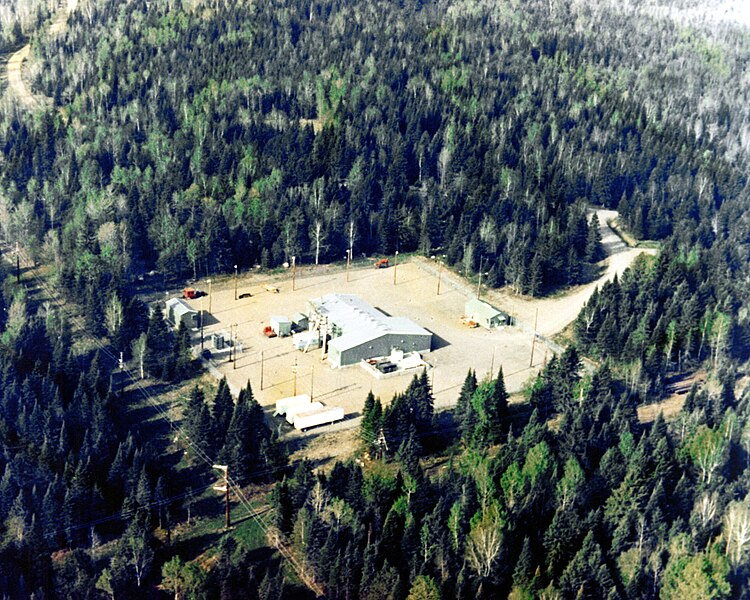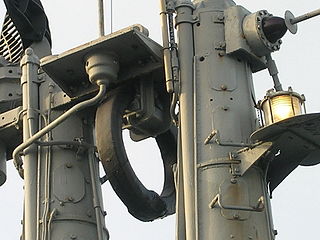Extremely low frequency
Extremely low frequency (ELF) waves are electromagnetic radiation (radio waves) with frequencies from 3 to 300 Hz, and corresponding wavelengths from 100,000 to 1000 kilometers. In atmosphere science, an alternative definition is usually given, from 3 Hz to 3 kHz. In the related magnetosphere science, the lower frequency electromagnetic oscillations (pulsations occurring below ~3 Hz) are considered to lie in the ULF range, which is thus also defined differently from the ITU Radio Bands.
ELF radio waves are generated by lightning and natural disturbances in Earth’s magnetic field, so they are a subject of research by atmospheric scientists. Because of the difficulty of building antennas that can radiate such long waves, ELF frequencies have been used in only a very few man-made communication systems. ELF waves can penetrate seawater, so the US and Russian militaries have used ELF transmission facilities to communicate with their submerged submarines. The frequency of alternating current flowing in electric power grids, 50 or 60 Hz, falls within this frequency band, and power grids are an unintentional source of ELF radiation.

Military communications
The United States Navy utilized extremely low frequencies (ELFs) as radio band and radio communications. The Submarine Integrated Antenna System (SIAS) was a research and development effort to communicate with submerged submarines. The Soviet/Russian Navy also utilized ELFs for submarine communications system, ZEVS.
Explanation
Because of its electrical conductivity, seawater shields submarines from most higher frequency radio waves, making radio communication with submerged submarines at ordinary frequencies impossible. Signals in the ELF frequency range, however, can penetrate much deeper. Two factors limit the usefulness of ELF communications channels: the low data transmission rate of a few characters per minute and, to a lesser extent, the one-way nature due to the impracticality of installing an antenna of the required size on a submarine (antennas need to be of exceptional size for the users to achieve successful communication). Generally, ELF signals were used to order a submarine to rise to a shallow depth where it could receive some other form of communication.

Ecological impact
There have been some concerns over the possible ecological impact of ELF signals. In 1984 a federal judge halted construction requiring more environmental and health studies. This judgment was overruled by a federal appeals court on the basis that the US Navy claimed to have spent over 25 million dollars studying the effects of the electromagnetic fields with results indicating that they were similar to the effect produced by standard power distribution lines. The judgment was not accepted by everyone and during the time ELF was in use, some Wisconsin politicians such as Senators Herb Kohl, Russ Feingold and Congressman Dave Obey called for its closure. Similar concerns have in the past been raised about electromagnetic radiation and health.
Natural sources
Naturally occurring ELF waves are present on Earth, resonating in the region between ionosphere and surface. They are initiated by lightning strikes that make electrons in the atmosphere oscillate. Though VLF signals were predominantly generated from lightning discharges, it was found that an observable ELF component (slow tail) followed the VLF component in almost all cases. The fundamental mode of the Earth-ionosphere cavity has the wavelength equal to the circumference of the Earth, which gives a resonance frequency of 7.8 Hz. This frequency, and higher resonance modes of 14, 20, 26 and 32 Hz appear as peaks in the ELF spectrum and are called Schumann resonance.

They have also been tentatively identified on Saturn’s moon Titan. Titan’s surface is thought to be a poor reflector of ELF waves, so the waves may instead be reflecting off the liquid-ice boundary of a subsurface ocean of water and ammonia, the existence of which is predicted by some theoretical models. Titan’s ionosphere is also more complex than Earth’s, with the main ionosphere at an altitude of 1,200 km (750 mi) but with an additional layer of charged particles at 63 km (39 mi). This splits Titan’s atmosphere into two separate resonating chambers. The source of natural ELF waves on Titan is unclear as there doesn’t appear to be extensive lightning activity.
Finally, huge ELF radiation power outputs of 100,000 times the Sun’s output in visible light may be radiated by magnetars. The pulsar in the Crab nebula radiates powers of this order at the frequency 30 hertz. Radiation of this frequency is below the plasma frequency of the interstellar medium, thus this medium is opaque to it, and it cannot be observed from Earth.
Größere KartenansichtExposure
In electromagnetic therapy and electromagnetic radiation and health research, electromagnetic spectrum frequencies between 0 and 100 hertz are considered extremely low-frequency fields. Since the late 1970s, questions have been raised whether exposure to ELF electric and magnetic fields (EMF) within this range of frequencies produces adverse health consequences. In October 2005, WHO convened a Task Group of scientific experts to assess any risks to health that might exist from “exposure to ELF electric and magnetic fields in the frequency range >0 to 100,000 Hz (100 kHz) in regards to childhood leukaemia.” There are established biological effects from acute exposure at high levels (well above 100 µT) that are explained by recognized biophysical mechanisms. External ELF magnetic fields induce electric fields and currents in the body which, at very high field strengths, cause nerve and muscle stimulation and changes in nerve cell excitability in the central nervous system. Health effects related to short-term, high-level exposure have been established and form the basis of two international exposure limit guidelines (ICNIRP, 1998; IEEE, 2002). At present, these bodies consider the scientific evidence related to possible health effects from long-term, low-level exposure to ELF fields insufficient to justify lowering these quantitative exposure limits. The long-term, low-level exposure is evaluated as average exposure to residential power-frequency magnetic field above 0.3 to 0.4 µT, and it is estimated that only between 1% and 4% of children live in such conditions. A common source of ELF fields in the United States is 60 Hz electric and magnetic fields from high-voltage electric power transmission lines and secondary distribution lines, such as those found in residential neighborhoods. The International Agency for Research on Cancer (IARC) has evaluated the scientific data and has classified ELF magnetic fields as being “possibly carcinogenic” to humans. IARC based this classification on the following:
Human health population studies showing weak evidence of an association with childhood leukemia; and a large database of laboratory study results showing inadequate evidence of an association with cancer in animals.
To put this into context, it is important to understand that the “possibly carcinogenic” classification is also applied to coffee, gasoline engine exhaust and pickled vegetables, and is often used for agents that require further study. In summary, when all of the studies are evaluated together, the evidence suggesting that EMFs may contribute to an increased risk of cancer is very weak. Epidemiological studies suggest a possible association between long term occupational exposure to ELF and Alzheimer’s disease.
See also: